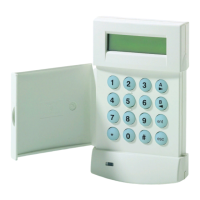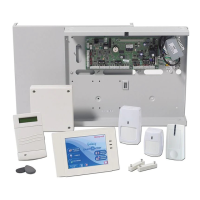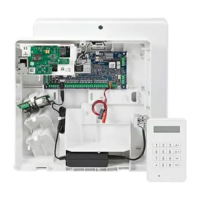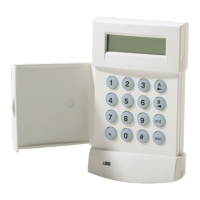Galaxy Flex Installer Manual Communications [56]
145
Triggers [56.1.2.1.2]
When you select the option, the first trigger event is displayed (see Table 10 for a list of
available triggers). These are the events and alarms that are transmitted to the ARC or
computer. If the trigger status is set to 1=Enabled, an event activation results in
transmission of the event details to the receiver. The triggers are available to the Telecom
module, the USB module and the Ethernet module.
Trigger Event Trigger Event
01=PA/Duress 11=Modules/Comms
02=Intruder 12=Elec. Status
03=Security 13=Menu Access
04=Custom Zones 14=Trouble
05=Fire 15=Log Zone
06=Set Fault 16=Max Tag
07=Omit 17=Zone Restoral
08=Tamper 18=RF Supervision
09=Setting 19=Fault
10=Reset/Cancel
Table 10 Trigger Events
To enable or disable a trigger event:
1. Scroll to the trigger you want to enable or disable, and then press ent.
2. Press 1 to enable or 0 to disable, and then press ent.
AUX 1 Report [56.1.2.2]
Use this section to configure an independent sequence of receiver reporting where dual
notification is required. Programming of Secondary Reporting is identical to ARC
Reporting.
Aux 2 Report [56.1.2.3]
Aux 3 Report [56.1.2.4]
Use these sections to programme any additional, lower priority alarm signalling
Aux 2 and Aux 3 are programmed as per the ARC Report [56.1.2.1].
DTMF Report [56.1.2.5]
Use this section to configure alarm signalling using DTMF format. It is configured in the
same way as ARC Reports but uses channel triggers instead of Event Triggers. For each of
the 8 channels there are four options: 1 = Op Function, 2 = Output Mode, 3 = Op Polarity
and 4 = Restoral. The first three options are programmed in exactly the same way as outputs.
See Program Outputs [53] for details. 4 = Restoral has these sub-options: 0 = Alarm Only
and 1 = Restore.
Note: Use DTMF receivers only in this sequence.

